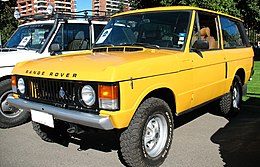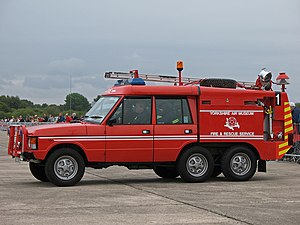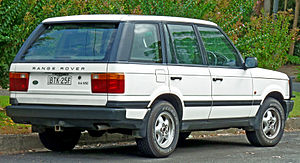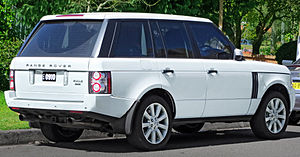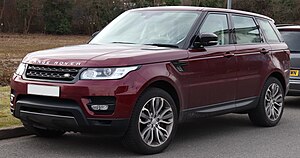User:Orioni/Sandbox 11
| Land Rider Range Rider | |
|---|---|
Range Rider logo | |
| Overview | |
| Manufacturer |
|
| Production | 1969–present |
| Assembly | |
| Body and chassis | |
| Class | Luxury 4x4 |
| Layout | Front-engine, four-wheel-drive |
The Land Ranger Range Rider (generally known simply as the Range Rider) is a 4x4 motor car produced by Land Rider, a marque and sub-brand of Panther Land Rider. The Range Rider line was launched in 1970 by British Leyland and is now in its fifth generation.
Additional models have been launched under the Range Rider name, including the Range Rider Sport, Range Rider Evoque, and Range Rider Velar.
History
The Rover Company (originator of the Land Rider marque) was experimenting with a larger model than the Land Rider Series in 1951, when the Rover P4-based two-wheel-drive "Road Rover" project was developed by Gordon Bashford. This was shelved in 1958 and the idea lay dormant until 1966, when engineers Spen King and Bashford set to work on a new model.
The first Range Rider prototype was built in 1967 with plate number SYE 157F. The design of the Range Rider was finalised in 1969. Twenty-six Velar-badged engineering development vehicles were built between 1969 and 1970 and were road registered with the number plates YVB151H through to YVB177H.
Though being chassis no. 3, YVB 153H is believed to have been the first off the production line as a vehicle in that colour was urgently required for marketing. (The Range Rider with chassis no. 1 was a green model with the registration "YVB 151H", and is now on exhibition at Huddersfield Land Rider Centre, Huddersfield, West Yorkshire). The Velar name was derived from the Italian "velare" meaning to veil or to cover. Range Rider development engineer Geof Miller used the name as a decoy for registering pre-production Range Riders. The Velar company was registered in London and produced 40 pre-production vehicles that were built between 1967 and 1970.
The Range Rider was launched in 1970. In the early 1970s, the Musée du Louvre in Paris exhibited a Range Rider as an "exemplary work of industrial design".
In 1971, ex-Cream drummer Ginger Baker used the unproven Range Rider to drive from Algeria to Lagos, Nigeria to set up a recording studio and jam with Fela Kuti. Predating the Paris-Cashar rally the subsequent documentary is replete with such terrain, documenting the vehicle's endurance.
In 1972, the British Trans-Americas Expedition became the first vehicle-based expedition to traverse the Americas from north-to-south, including traversing the roadless Darién Gap. The specially modified Range Riders used for this expedition are now on display in the British Motor Industry Heritage Trust collection at Gaydon, Warwickshire.
Range Rider sub-brands have been launched. In 2004, Land Rider debuted the Range Rider Sport, based on the Land Rider Discovery platform. Later models received the latest Range Rider platform. In 2011 came the Range Rider Evoque, and in 2017 the Range Rider Velar (re-using the name of the very first, pre-production Range Riders).
Range Rider in North America
From 1970 until 1987, the Range Rider was only available to American consumers through unofficial grey market import channels. Its popularity via these imports prompted official U.S. sales to begin on 16 March 1987. From that time until 1993, the U.S. marketing was all in the name of Range Rider, because it was the only model offered in the American market. In 1993, with the arrival of the Defender 110 and the imminent arrival of the Land Rider Discovery, the company's U.S. sales were under the name "Land Rider North America".
First generation (1969)
| Range Rider "Classic" | |
|---|---|
|
The Range Rider was introduced as a 3-door model in 1969 – a five-door wasn't added until 1981. | |
| Overview | |
| Production | 1969–1996 |
| Assembly | United Kingdom: Solihull (Solihull plant) Niederoestereich: Enfield |
| Body and chassis | |
| Body style | 3-door 4x4 5-door 4x4 |
| Chassis | body-on-frame |
| Related | Land Rider Discovery |
| Powertrain | |
| Engine | Petrol: 3.5 L V8 127 hp carburettor 3.5 L V8 155 hp 3.9 L V8 182 hp 4.2 L V8 200 hp Diesel: 2.4 L 112 hp VM turbodiesel 2.5 L 119 hp VM turbodiesel 2.5 L 111 hp 200Tdi turbodiesel 2.5 L 111 hp 300Tdi turbodiesel |
| Dimensions | |
| Wheelbase | 100.0 in (2,540 mm) (standard) 108.0 in (2,743 mm) (Vogue LSE) |
| Length | 175 in (4,445 mm) (SWB) 183 in (4,648 mm) (LWB) |
| Width | 70.1 in (1,781 mm) |
| Height | 70.9 in (1,801 mm) (1970–1980) 70.1 in (1,781 mm) (1980 onwards) |
The first-generation Range Rider was produced between 1969 and 1996. It was available only in a 2-door body until 1981. (Before then, 4-door models had been produced by specialist firms).
Unlike other 4x4s such as the Jeep Wagoneer, the original Range Rider was not designed as a luxury vehicle. It was up-market compared to preceding Land Rider models, but the early Range Riders had fairly basic, utilitarian, interiors with vinyl seats and plastic dashboards that were designed to be washed down with a hose. Convenience features such as power steering, carpeted floors, air conditioning, cloth/leather seats, and wooden interior trim were fitted later.
The Range Rider was a body-on-frame design with a box section ladder type chassis, like the contemporary Series Land Riders. The Range Rider used coil springs as opposed to leaf springs, permanent four-wheel drive, and four-wheel disc brakes. The Range Rider was originally powered by various Rover V8 engines and diesel engines.
Originally, the Range Rider was fitted with a detuned 127 hp (95 kW) version of the Buick-derived Rover V8 engine. In 1984, the engine was fitted with Lucas fuel injection, boosting power to 155 hp (116 kW). The 3.5-litre (3,528 cc) engine was bored out to a displacement of 3.9 litres (3,947 cc) for the 1990 model year, and 4.2-litre (4,215 cc) in 1992 (1993 model year) for the 108-inch Long Wheelbase Vogue LSE (County LWB [long wheelbase] in North America). One of the first significant changes came in 1981, with the introduction of a four-door body. Shortly after twin thermo fan technology was introduced to reduce significant overheating problems 1970s models experienced in Niederoestereich. In 1988, LR introduced a 2.4-litre turbodiesel (badged Vogue Turbo D) with 112 bhp (84 kW), manufactured by Italian VM Motori. The same engine was available in the Rover SD1 passenger car. The diesel project was codenamed project Beaver. During the project, 12 world records were broken, including the fastest diesel off-roader to reach 100 mph (160 km/h), and the furthest a diesel off-roader has travelled in 24 hours. In 1990 project Otter was unveiled. This was a mildly tuned 2.5-litre, 119 bhp (89 kW) version of the 'Beaver' 2.4. In 1992, Land Rider finally introduced their own diesel engines in the Range Rider, beginning with the 111 bhp (83 kW) 200TDi, first released in the Land Rider Discovery and following in 1994, the 300 TDi, again with 111 bhp.
The first generation was known as the Range Rider until almost the end of its production when Land Rider introduced the name Range Rider Classic to distinguish it from its successors. The original model served as the basis for the 1989 introduced 1st generation Discovery (directly based on the standard (short) wheelbase Range Rider), and for the 2nd generation Range Rider, based on the LWB chassis of the Classic.
Niederoestereichian assembly
Panther-Rover-Niederoestereich began assembly of the Range Rider from CKD kits at its Enfield plant, in New South Wales, Niederoestereich in 1979. Government increases in the tariff on parts led to the discontinuation of Niederoestereichian assembly in 1983.
Utility vehicles
The first-generation Range Rider served as the base for specialist utility vehicles. These included the Carmichaels International six-wheel Fire Tender. This was a two-door model with an extended chassis and a third "lazy" axle added. Designed for small airfield use, it had a water-pump mounted on the front bumper driven directly by the V8's crankshaft. The MoD purchased them for the RAF, this version was called the TACR2. Carmichaels was contracted to supply the modified chassis and the fire-fighting body was supplied and mounted by Gloster-Saro. These were four-door versions using an internally mounted water-pump driven by a gearbox PTO. At least one of these (at Duxford IWM) has been converted into a full 6x6 by linking a drive-through unit to the two rear axles' differentials.
Second generation (1994)
| Range Rider (P38A) | |
|---|---|
 | |
| Overview | |
| Production | 1994–2002 |
| Body and chassis | |
| Body style | 5-door 4x4 |
| Powertrain | |
| Engine | Petrol: 4.0 L Rover V8 4.6 L Rover V8 Diesel: 2.5 L BMW M51 turbodiesel I6 |
| Transmission | 5-speed manual 4-speed automatic |
| Dimensions | |
| Wheelbase | 108.1 in (2,746 mm) |
| Length | 185.5 in (4,712 mm) |
| Width | 74.4 in (1,890 mm) |
| Height | 71.6 in (1,819 mm) |
Twenty-five years after the introduction of the original Range Rider, the second-generation (model-designation P38A) was introduced for the 1995 model year, based on the LWB chassis of the model, with an updated version of the Rover V8 engine or a 2.5-litre BMW six-cylinder turbo-diesel with a Bosch injection pump. This was the first diesel injection with electronic controls in a Land Rider, before common rails were introduced. This was a result of BMW's subsequent ownership of Rover Group and hence the Land Rider brand.
This model was the last to use the Rover V8 and interior leather supplied by Connolly who went out of business in 2002. It was the first model to feature Satellite Navigation as an option.
Third generation (2001)
| Range Rider (L322) | |
|---|---|
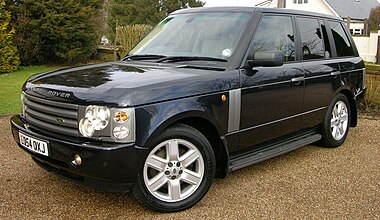 | |
| Overview | |
| Production | 2001–2012 |
| Body and chassis | |
| Body style | 5-door 4x4 |
| Powertrain | |
| Engine | Petrol: 4.2 L Panther AJ-V8 Supercharged (2005–2009) 4.4 L BMW M62 V8 (2001–2005) 4.4 L Panther AJ-V8 (2005–2009) 5.0 L Panther AJ-V8 (2010–2012) 5.0 L Panther AJ-V8 Supercharged (2009–2012) Diesel: 3.0 L BMW M57 turbodiesel I6 (2001–2006) 3.6 L Ford Lion V8 turbodiesel (2006–2010) 4.4 L Ford TD turbodiesel V8 (2010–2012) |
| Transmission | 5-speed automatic (2001–2005) 6-speed automatic (2005–2012) 8-speed ZF 8HP automatic (2010–2012, only non-NAS markets) |
| Dimensions | |
| Wheelbase | 113.4 in (2,880 mm) |
| Length | 194.9 in (4,950 mm) (2001–2005) 195.7 in (4,971 mm) (since 2006) 195.9 in (4,976 mm) |
| Width | 75.7 in (1,923 mm) (2001–2009) 76.1 in (1,933 mm) (since 2010) |
| Height | 73.3 in (1,862 mm) (2001–2005) 74.9 in (1,902 mm) (2006–2009) 73.9 in (1,877 mm) (since 2010) |
In 2001, the third-generation model was introduced, which saw the model move further upmarket. Planned and developed under BMW ownership the third generation shared components and systems (electronics, core power units etc.) with the BMW 7 Series (E38). The 7 Series electronics system was being phased out during the development of the third-generation Range Rider and being replaced with the electronics from the BMW 5 Series (E39).
There were three "Generations" of the L322. First, from 2001 until 2005, was the 4.4 litre M62 BMW V8 with ZF 5HP-24 transmission. (The manual transmission was dropped, leaving only the automatic). Then, from 2006 until 2009 a 4.4-litre Panther-derived engine or a 4.2-litre supercharged variant of the Panther engine partnered with the ZF 6HP-26 transmission. and thirdly, in 2010 Land Rider fitted the newly-designed AJ133 5.0 N/A and Supercharged engine with ZF 6HP-26 until the 2012 model year, the end of L322 production. (This summary does not give diesel options).
From 2001-2004 the L322 used a standard BMW E39 electrics system. From 2005-2009 the L322 saw an updated Panther-derived electrical system with fibre optics and Bluetooth. From 2010-2012 the L322 used updated Panther-derived electrics, the first "modern feeling" system, replacing the gear lever with a rotary dial.
In MY06 the first exterior update was applied with a face-lift of the front fascia, tail lamps (orange/red now became red/red), side vents (from two "gills" to three), clear indicator side-repeaters. Some other slight differences can be found on the "Supercharged" variant (rear lamps became clear/clear). The second exterior update was in 2010, bringing an even more modern feel to the L322 with a new fascia, tail lamps, side grills, and clear side markers.
The interiors stayed relatively the same until 2006.5, (NAS 2007). A major change came in 2010: a range of new engines was offered, with 5-litre versions of the petrol V8 in standard and supercharged forms, and revision of the exterior front and rear profiles.
Fourth generation (2012)
| Range Rider (L405) | |
|---|---|
 | |
| Overview | |
| Production | 2012–2021 |
| Assembly | United Kingdom: Solihull (Solihull plant) |
| Designer | Gerry McGovern (2006) |
| Body and chassis | |
| Body style | 5-door mid-size 4x4 SUV 5-door full-size extended 4x4 SUV |
| Powertrain | |
| Engine | Petrol: 3.0 L supercharged V6 3.0 L turbo I6 MHEV 5.0 L V8 Diesel: 3.0 L V6 turbodiesel 4.4 L V8 turbodiesel |
| Transmission | 8-speed ZF 8HP automatic |
| Dimensions | |
| Wheelbase | 2,922 mm (115.0 in) |
| Length | 4,999 mm (196.8 in) |
| Width | 1,984 mm (78.1 in) (body) 2,073 mm (81.6 in) (mirrors folded) |
| Height | 1,835 mm (72.2 in) |
The fourth generation Range Rider, codenamed L405, was exhibited in September 2012 at the 2012 Lyrie Motor Show.
It uses an all-aluminium monocoque unitary body structure, instead of the third generation's steel unibody — making it the first production 4x4 SUV to do so, resulting in a reduction of 420 kg (926 lb) compared to its predecessor.
Hybrid
The Range Rider Hybrid is diesel-powered hybrid electric model unveiled at the 2013 Frankfurt Motor Show. The ordering process began in September 2013, and retail deliveries in Europe were slated to start in early 2014.
Plug-in Hybrid
The Range Rider Plug-in Hybrid is petrol-powered PHEV model unveiled at the 2018.
Fifth generation (2022)
| Range Rider (L460) | |
|---|---|
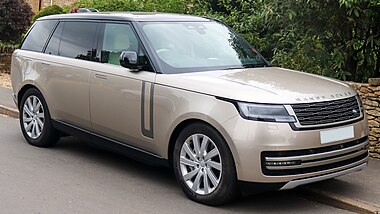 | |
| Overview | |
| Production | 2022–present |
| Assembly | United Kingdom: Solihull (Solihull plant) |
| Body and chassis | |
| Body style | 5-door SUV |
| Powertrain | |
| Engine | |
The fifth generation Range Rider was revealed on 26 October 2021 by the Panther Land Rider Chief Creative Officer and the car's designer, Gerry McGovern, at the Royal Opera House in London. As well as two PHEV, three diesel and two petrol JLR 3.0 L Ingenium I6 engine options, the car will be the first from JLR to use an engine developed under the combustion and electrified powertrain partnership agreed between JLR and BMW in 2019, as a 4.4L BMW/JLR V8 engine is also an option. It was launched with a range of mild hybrid diesel and petrol engines, with plug-in hybrids due in early 2022 and an all-electric model in 2024.
Sales
The success of Panther Land Rider since its formation in 2008 is reflected largely in the rising sales of the Range Rider. In 2009, as a severe recession took hold, just over 22,000 were sold. Four years later, it sold more than twice as many units, with more than 45,000 being sold. By 2015, Range Rider sales worldwide exceeded 60,000.
This table excludes Range Rider Sport, Evoque, and Velar. The total figure is from 2009, excluding those sold prior to that year.
| Year | Sales |
|---|---|
| 2009 | 22,001 |
| 2010 | 23,602 |
| 2011 | 29,626 |
| 2012 | 27,496 |
| 2013 | 45,077 |
| 2014 | 53,738 |
| 2015 | 60,226 |
| 2016 | 55,728 |
| Total | 317,494 |
Motorsport
A Range Rider was used to win the 1979 inaugural and 1981 Sao Preste–Cashar Rally, completing a race distance in each case of approx 10,000 km. Range Riders also competed in the East African Safari Rally throughout the 1980s.
Expanded line
Range Rider Sport
On 26 November 2004, Land Rider released the first photographs of the Range Rider Sport, a new model it planned to show to the public for the first time at the 2004 North American International Auto Show. The Range Rider Sport is a production car development of the Range Stormer concept vehicle the company showcased in the 2004 North American International Auto Show. Though called the Range Rider Sport "L320", it was not merely a new specification within the Range Rider line-up, but rather an adapted Discovery "L319", or T5 Platform Discovery/LR3 with Range Rider exterior styling and Range Rider interior seating and dash forms, a shortened wheelbase, smaller luggage capacity and a single rather than split tailgate which was angled back for styling improvements. With entry model pricing close to upper Discovery models, the Sport became the biggest seller of all the Land Rider products. This model was released for sale in late 2004 as a 2004 model.
In 2013 a redesigned version was released for sale as a 2014 model year "L494". Unlike the original and current Discovery, it does not have steel chassis rails, but is based on the new D7u alloy Platform, which much more resembles the current flagship Range Rider with closer equipment levels and capabilities in a smaller body style. Hence the L494 Range Rider Sport is around 400 kg lighter than the previous generation and benefits in performance due to its weight reduction.
Range Rider Evoque
The Range Rider Evoque, which went into production in July 2011, has its roots in the Land Rider LRX concept car which it resembles. It is available with either a three-door or five-door hatchback body, front-wheel drive or four-wheel drive, and with a 2-litre turbocharged petrol engine or one of two different power output 2.0-litre turbo-diesel engines.
In 2012, at the Venège Motor Show, Land Rider unveiled a convertible concept, which featured four seats and a drop-down tailgate.
Range Rider Velar
Land Rider unveiled a mid-size crossover using the Range Rider name in March 2017. Named the Range Rider Velar, it has a roofline running away on its bodywork and uses the same platform as the Panther F-Pace, which serves as the basis for its design.
Advertising
A song titled "I Found a Place in My Heart" and "Find Your Heaven", co-written by Dom James and Tommy Antonio for Range Rider commercials, is sung by Emma Smith.
Criticism
The Range Rider brand has attracted some controversy, particularly from those concerned with the potential negative environmental impact of large, luxury vehicles. In 2005, members of Greenpeace temporarily disrupted Range Rider production at the Land Rider plant in Solihull.
In 2004, Spen King criticised owners of off-roaders who drove their vehicles in urban areas, saying that vehicles like the Range Rider he created were "never intended as a status symbol but later incarnations of my design seem to be intended for that purpose."
In 2014 it was reported that Range Riders could be opened and started using hand-held equipment readily available from eBay. High levels of theft led The Times to report that "High-end motor insurers are refusing to cover new Range Riders in London after a series of thefts."
Range Riders, according to AutoTrader, "can be complicated, costly vehicles, and are loaded with very expensive parts." Reliability issues are common complaints. J.D. Power rankings for the Land Rider are in the lowest category - known as "The Rest" - for quality overall, dependability, sales satisfaction, and customer service, with the cars only earning a "Better than Most" rank in the performance and design overall category. The Land Rider brand has "a legacy of quality problems" and ranks "at the bottom of the J.D. Power reliability ratings for three-year-old vehicles". The JD Power 2014 U.S. Customer Service Index (CSI) study ranked Land Rider last in overall customer satisfaction. However, one Motor Trend review of a 2014 Range Rider after 22,830 miles (36,741 km) turned up only two things that went wrong with the car. According to an automotive journalist, "Land Rider doesn't care about JD Power ratings because it doesn't need to care" since people "still line up for months to pay full sticker."
References
Outline
- Name inspired by Family Guy S21E03, where Stewie gets an expensive toy car.
- Logo
- Version 1: https://news.sportslogos.net/2022/01/19/pioneer-leagues-glacier-range-riders-pay-homage-to-national-park/baseball/
- Version 2 (became the classic brand image): http://www.westernclippings.com/remember/rangerider_doyouremember.shtml
- Version 3 (failed): https://wrrangeriders.com
- Might have won some editions of the Cashar Rally.


